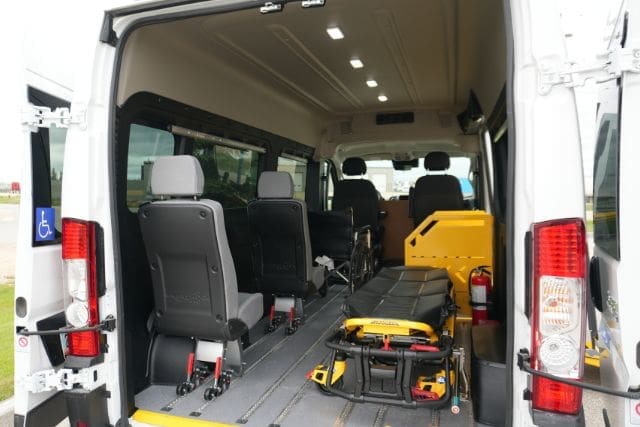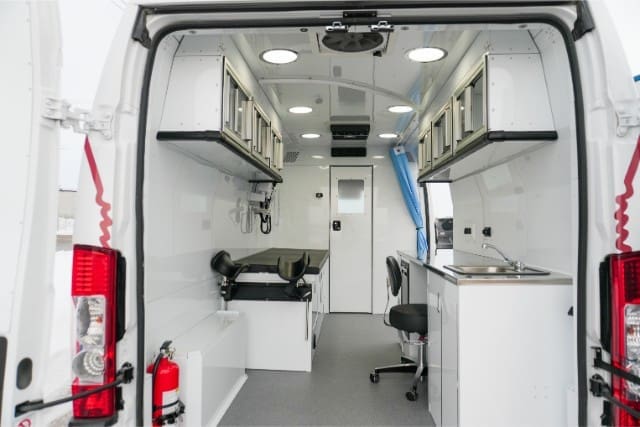Buying something like a wheelchair van is almost like buying a house.
You’re investing your money in something you or your organization will be using every day. So, you need to do some exploring to determine what, exactly, you’re looking for.
When house hunting, you typically start with a list of requirements the house needs to have before you’ll even go look at it. You know enough basic information to get you started: you’re a family of 4, and you need more than 1 bathroom, so you’ll turn to Google for a quick search:
“Three-bedroom, 2-bathroom home, 5-minute walk from the grocery store.”
And hundreds of results will pop up showing you houses in your area.
But when it comes to looking at wheelchair vans, that first step isn’t so simple. How do you know what type of wheelchair van is right for you? Your budget is less than $100,000… can you even afford one? You want to transport two wheelchairs and three passengers…how big does your van need to be?
At MoveMobility, we want to make these initial steps toward buying a wheelchair van easier for you, and that means giving you all the information you need to make this vital decision in one place.
In this article, you’ll learn:
- How Do You Choose the Right Wheelchair Van? (8 Steps)
- How Long Does it Take to Buy a Wheelchair Van?
- How Much Does a Wheelchair Van Cost?
- What Grants/Funding is Available for Wheelchair Vans?
- What are the Different Types of Wheelchair Vans?
- Ramps vs. Lifts: Which is Right for Your Wheelchair Van?
- Should You Buy a Wheelchair Van from a Manufacturer or a Dealership?
- How Do You Get Service on Your Wheelchair Van?
Read on to learn everything you need to know to find the right wheelchair van for you–whether you’re a nonprofit, a transportation provider, a medical transportation provider, an adult daycare, a community outreach and support program, or a personal user looking for a wheelchair van for their family.
How Do You Choose the Right Wheelchair Van? (8 Steps)
There are many different factors to consider when buying a wheelchair van, and each factor will affect how successful the wheelchair van is for your passengers.
If you choose a lift when you should have picked a ramp? The lift may not work properly and your passengers may miss key engagements, such as doctor’s appointments.
If you buy a used wheelchair van when you should have gone with something new? Your van may not be tailored to your passengers’ needs and they may not feel comfortable riding in it.
That’s why in this section of this article, you’ll learn the 8 initial steps you can take to help you decide which wheelchair van is right for you.
1. Decide if you want your van to be new or used
A new van is more reliable, has fewer service problems, and will be converted using the most recent conversion designs. You’ll be able to customize your van and completely tailor it to your passengers’ specific needs.
For example, if you will be transporting walker-users, they may be more comfortable using a ramp because a lift suspends them about 3 feet in the air (which can be uncomfortable and even frightening for some passengers). With a new van, you’ll be able to customize your conversion and have a ramp installed.
On the other hand, a used van may be cheaper, likely has more service problems, and has already been converted–meaning you won’t be able to request specific conversions.
To put it simply: What you get is what you get, and what you get may not be what you need.
2. Choose a side entry or rear entry van
The next step to choosing the right wheelchair van for your passengers is picking between a side entry and a rear entry van.

Side entry: passengers load and unload from the side of the vehicle.
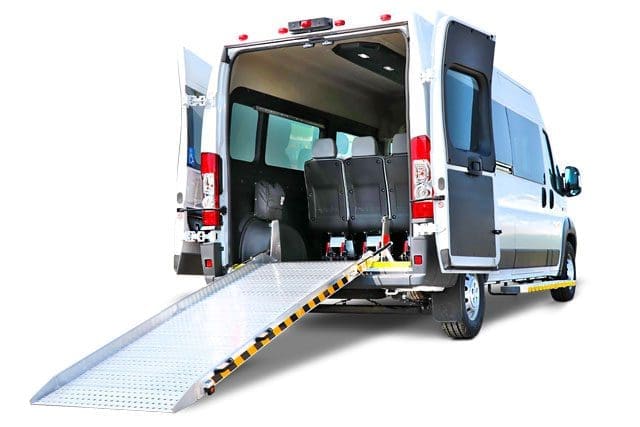
Rear entry: passengers load and unload from the back of the vehicle.
Check out this table for a general overview of the differences between a rear entry van and a side entry van.
| Side Entry | Rear Entry |
| Load from curbs | No special parking spot required |
| Requires space on the side to lower the ramp | Can be unsafe if you’re unloading the wheelchair on a busy street at the van’s rear |
| Best for passengers with any mobility level (wheelchair, walker, ambulatory) | You don’t have to turn wheelchairs once inside (straight in, straight out) |
For more information on whether rear entry or side entry is right for you, check out this related article.
3. Choose a lift or a ramp
Deciding whether you want a ramp or a lift can be one of the hardest choices in this process. Here are some facts to consider:

1. Ramps allow passengers to be independent and are easy to use for wheelchairs, but you have to make sure the driver can push a manual wheelchair up the ramp.
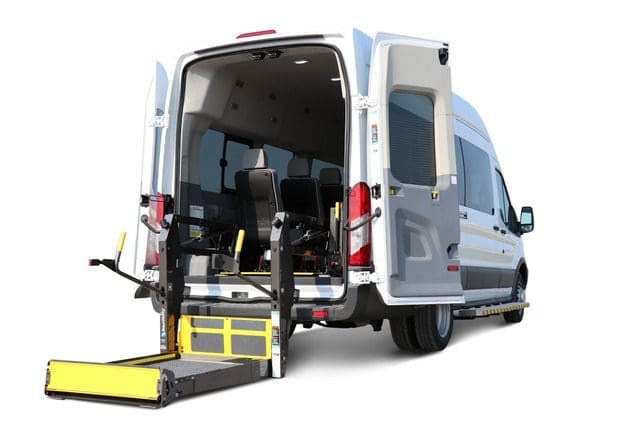
2. Lifts, on the other hand, require no physical effort from drivers. One thing to consider, though, is that ambulatory passengers have to go up steps to enter the van because a lift usually blocks the rear or side doorway.
For a deeper look into the pros and cons of lifts vs. ramps, check out this related article.
4. Figure out how many wheelchairs the van will be taking regularly
The number of wheelchairs the van will be taking on a regular basis is very important to determine what size van you will need (either a full size van, a minivan, or a cutaway bus).
Here’s a short breakdown of wheelchair numbers and their corresponding van sizes:
- 1-2 wheelchairs: accessible minivan
- 1-4 wheelchairs: full-size accessible van
- 4+ wheelchairs: you may need to consider a cutaway bus
5. Determine if you will need to transport walkers
Will you be transporting walker users? If so, a van with a low ramp incline is best to make sure it’s not too steep. At MoveMobility, our power ramp has a low incline angle of about 11 degrees.
It’s also important to note that sometimes lifts can be intimidating for people with walkers and even make them uncomfortable because it suspends them about 3 feet in the air.
6. Determine the type, size, and weight of the wheelchairs you’ll be transporting
The angle of the ramp is an important factor to consider when buying a wheelchair van. A powered wheelchair can make it easier to get up a steeper ramp, and a manual wheelchair can make it more difficult.
Generally, the bigger the ramp, the easier it is to use. So, knowing the size and weight of the wheelchair helps determine whether a van with a ramp or lift is right for your program.If your wheelchairs are bigger and heavier than average, a lift may be right for you.
Another important factor to consider is that every wheelchair van has a slightly different amount of headroom–the amount of space between the wheelchair user’s head and the roof of the van.
Knowing the height of the person when they are seated in their wheelchair will help you decide if a certain vehicle or entry method is better for you. This is especially important if you are considering a minivan, because minivans are smaller and, naturally, will have less headroom.
7. Determine how often you’ll be going on long trips
Just like any other non-wheelchair-accessible vehicle, it is important for your passengers to be comfortable in the vehicle–especially if they will be frequently going on long trips.
Some vans ride nicer than others or offer other amenities and knowing if you need a van with the most comfortable rider experience can help you narrow down what van you need.
8. Decide on a budget
Your budget will ultimately depend on what vehicle you choose. Click here to learn what makes up the cost of a wheelchair van and why.
Now that you know the 8 steps you can take to determine which wheelchair van is right for you, you may be wondering how long it takes to actually get a wheelchair van. Read on to find out.
How Long Does it Take to Buy a Wheelchair Van? (The Process with MoveMobility)
There’s always one question we get asked here at MoveMobilty within our first few conversations with clients:
“How long does it take to get a wheelchair van?”
Of course, we understand why this question is so frequently asked. Time is a valuable thing–especially your time.
Knowing what your timeline looks like before you invest in a wheelchair van is vital, because each manufacturer, dealership, and van themselves may have very different timelines.
That’s why we’re going to answer all of your questions about timelines and the process of securing a wheelchair van in 2023 right here, right now.
By the end of this section, you’ll know the definition of “lead times”, what factors can impact your timeline, and the steps we would take you through if you decided to purchase one of our vans.
First, let’s define what you’ll probably hear our sales team talk about a lot during this process: lead times.
What is a lead time?
A lead time is the amount of time that will pass between you ordering a wheelchair-accessible van to the van being in your driveway.
Your lead time depends on 4 key factors
The time it will take to have your van in front of you depends on many factors–some that are in your control, and some that are out of it.
These factors include:
- Where you are in the process of securing your van
- The time of the year and where you are
- The vehicle you ordered
- The vans we have in stock
Let’s take an in-depth look at each factor to determine your lead time.
1. Where you are in the process
The process of ordering your van can be a long one. This is because of all the stages in-between ordering and delivering–from taking payment to making the conversions.
If you decide to buy a wheelchair van from MoveMobility, there will be 3 main stages you’ll go through:
- You provide us with a deposit ($25,000) and sign paperwork
- We build your van
- You provide us with a final payment, then we deliver your van to you
Where you are in this process will affect your timeline.
But these two factors affect your timeline the most: the time of the year when you ordered your van and where you live.
2. The time of the year and where you live
Our lead times are constantly changing depending on the time of the year. But generally, they fall between three to eight months. That being said, if you have a specific deadline in mind, we do our best to accommodate it.
An important factor to consider is where you are. If you live in or near Winnipeg, Manitoba, you have the option to pick up the vehicle you ordered.
But if you live outside of Manitoba, we will deliver the vehicle to you. As I’m sure you’ve guessed, this means the further you are from us, the longer it will take to deliver your van.
3. The vehicle you ordered
Different vehicles we offer take more or less time to convert.
For example, our P Series vans (Ram Promaster) have a lead time of about three to six months. Of course, this isn’t to say you should choose a vehicle based on how long it will take to get to you–you should always choose what vehicle and conversions are right for you.
With that in mind, we also offer the option of special orders–meaning you could ask for very specific conversions we don’t typically offer. Special orders can take anywhere from six months to two years to complete, depending on how difficult they are to build.
4. The vans we have in stock
A question often get asked at MoveMobility is:
“Do you have vans in stock?”
The answer is both yes and no. Yes, we do have vans available. But they haven’t all been converted to be wheelchair vans yet. That’s why our lead times have so much range.
Do you want an update on our current lead times? Talk to a MoveMobility expert.
Or, are you ready to learn how much a wheelchair van costs? Read on to find out.
How Much Does a Wheelchair Van Cost?
Wheelchair vans have many variables and options that may or may not be right for your community or organization. If you’re in the market for a mobility vehicle, you need to have an understanding of the costs involved in this type of purchase.
That’s why in this section, you’re going to learn what a wheelchair van costs and why.
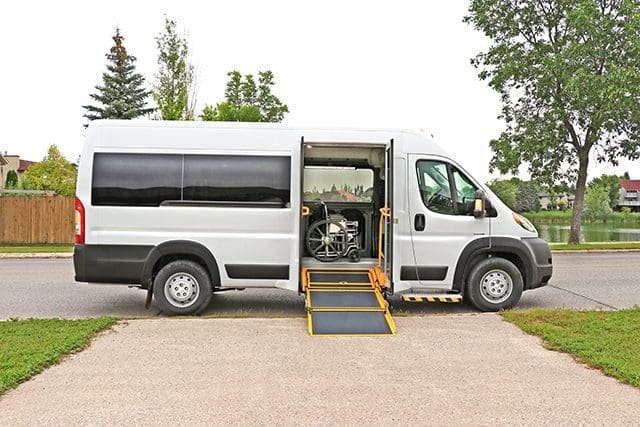
How Much Does a Wheelchair Van Cost? (Chart)
Below is a chart that lists ballpark costs for different types of wheelchair vans.
Budget ranges provided for informational purposes only. Subject to change without notice.
| Vehicle | Budget Range |
| P Series Accessible Vans | $130,000-$180,000 |
| Ram Promaster & Ford Transit Classic Series | $120,000-$155,000 |
| T Series Accessible Van | $145,000-$180,000 |
| VL Series | $110,000-$135,000 |
| Rear Entry Minivan with manual ramp conversion | $92,000-$110,000 |
Now that you know generally how much a wheelchair van costs, you may be wondering why some wheelchair vans are more expensive than others.
What drives the cost of a wheelchair van up?
In the automotive market, the actual vehicle frame or body is known as the chassis. Chassis costs have a large impact on the cost of a wheelchair van–often taking up around half of the total price, with the other half being the actual conversion.
The cost of a vehicle chassis isn’t something that accessible van manufacturers have much control over. You’ll find that the cost of the chassis purchased from a wheelchair van manufacturer is similar to the price you would pay for the same chassis at a dealership.
Aside from the cost of the vehicle itself, the wheelchair accessible conversion modification includes numerous other components, including:
- Lighting systems
- Safety equipment
- Removable seating
- The conversion type
- Custom medical equipment
- Wheelchair securement restraints
- Entry and exit assists (grab poles)
- Heating and air conditioning systems
- Interior paneling, insulation, and finishing
- Wheelchair access equipment: lift or ramp
- Whether the van has a flexible floor track system for seating and wheelchairs

As you can see, there are many components that affect the price of a wheelchair accessible van and conversion. It’s mainly the customization of the wheelchair van conversion that drives the cost of the vehicle up.
After looking at some of the prices you’ll need to budget for, you may be wondering if there are any grants or funding you can apply for to bring that cost down. Read on for a list of resources you can check out.
What Grants/Funding is Available for Wheelchair Vans?
Here are some resources to help you find the right funding and grant applications for your organization.
Government grants/funding
It’s a good idea to keep your eye out for government grants specific to your industry (adult daycares, remote First Nations communities, nonprofits, etc.). You can do this by frequently checking this page on the Government of Canada website.
Transport Canada
Transport Canada recently announced a new incentive for an electric van funding program that will “help businesses and communities across the country make the switch to zero-emission vehicles.”
The Government of Canada provides a list of eligible vehicles here.
Those eligible include organizations, businesses, municipal governments, and provinces and territories.
Indigenous Services Canada
Indigenous Services Canada is a great resource for Indigenous communities to get funding. They are consistently publishing new funding opportunities, some with deadlines and some without, so it’s a good idea to keep your eye on their website.
Jordan’s Principle Funding and First Nations Child & Family Services Funding
Indigenous Services Canada is accepting Jordan’s Principle funding requests for buying or building capital assets. Requests supporting First Nations child and family services and Jordan’s Principle are eligible.
This funding covers the following, intended for long-term use:
- Property
- Vehicles
- Buildings
- Spaces
Grant Connect
Grant Connect is an online tool that can help nonprofits find funding opportunities. However, you have to pay a subscription fee to get access to the website.
Now that you have a general understanding of how much a wheelchair van costs and what funding opportunities you should keep an eye out for, you’re ready to learn about the 3 types of wheelchair vans generally sold in the accessible vehicle industry: minivans, full size vans, and mobile medical vans. Read on to learn which is right for you.
What are the Different Types of Wheelchair Vans?
There are 2 types of wheelchair vans we sell at MoveMobility: minivans and full size vans.
To know which option is right for you, there are some key pieces of information you need to know:
- How many passengers the van can take (capacity)
- How big the van is (size)
- How much the van costs
- What license you need to drive the van
- Which models are used to convert the van
Take a moment now to look over the chart below so you can easily compare full size vans and minivans–and determine which fits your organization best.
| Minivan | Full Size Van | |
| Capacity | 1-2 wheelchairs or 4 passengers (or a configuration of both) | 1-4 wheelchairs or 10 passengers (or a configuration of both) |
| Size | 16.5 feet long, 6 feet tall, and 6 feet wide | Around 25 feet long, 7 feet tall, and 9 feet wide |
| Cost | $92,000 – $110,000 | $130,000 – $180,000 |
| Licensing | Standard Class 5 license (for most provinces) | Standard Class 5 license (for most provinces) |
| Models | Dodge Grand Caravan and Chrysler Grand Caravan | Ram Promaster and Ford Transit |
Now that you know which type of wheelchair van is right for you, your next step is to choose between a ramp or a lift.
Ramps vs. Lifts: Which is Right for Your Wheelchair Van
Ramps and lifts. You know both of them have the same result–getting passengers into a wheelchair van safely and securely–but the way they get there can be vastly different. So, which one is right for you?
Here at MoveMobility, we install ramps and lifts into wheelchair-accessible vans every single day, so we have a deep understanding of their strengths and their flaws.
In this section, you’ll learn what ramps and lifts are, how they’re different, and who they’re right for.
Wheelchair van ramps vs lifts: what’s the difference?
While both wheelchair van ramps and lifts are used to get passengers in and out of wheelchair vans, there is one major difference between the two.

A wheelchair van ramp is a platform that starts at the ground and travels up to the van at an angle.
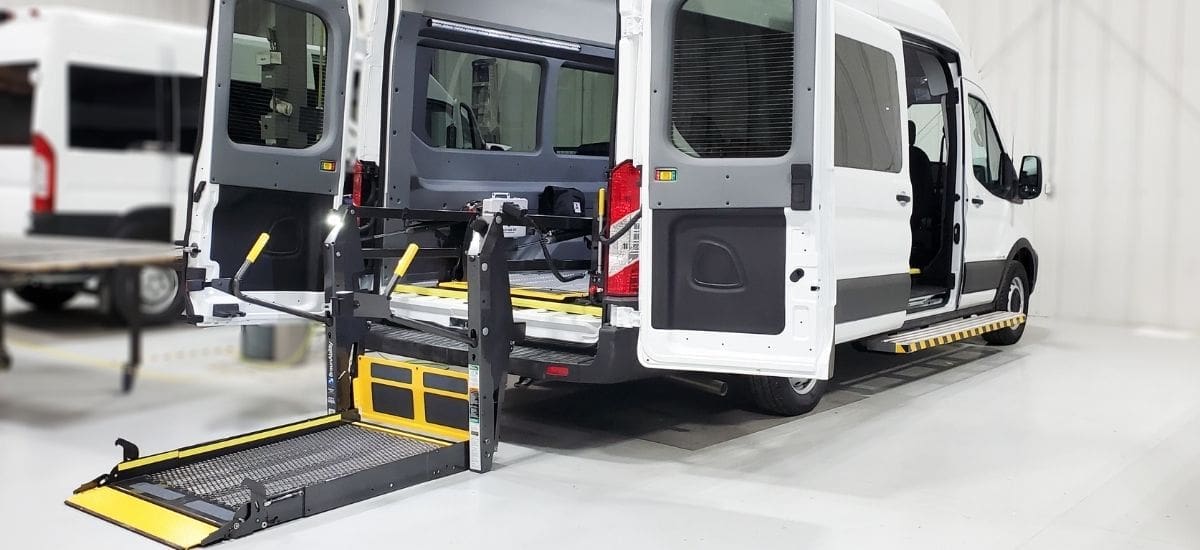
A wheelchair van lift will lift a passenger into the air until they are level with the van floor.
At MoveMobility, we have 2 different types of ramps for wheelchair vans. Read on to find out how they work.
Ramps for wheelchair vans–how they work (2 types)
We offer two kinds of ramps here at MoveMobility: manual ramps and powered ramps.
1. Manual ramps–what they are and how they work
You operate a manual ramp by unlatching it and lowering it to the ground. Then, a wheelchair user can be wheeled up the ramp or a walker user can walk up the ramp. Super simple.
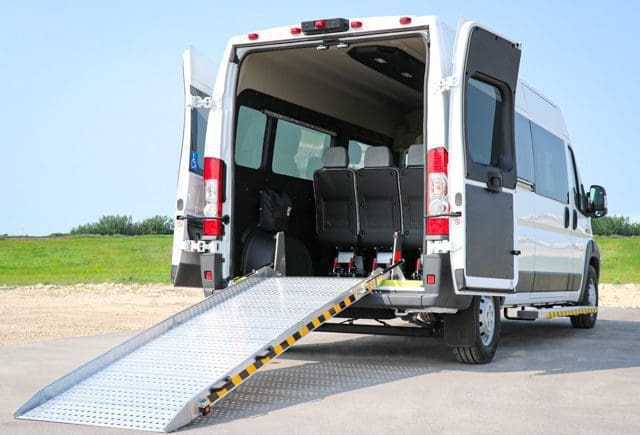
2. Powered ramps–what they are and how they work
What marks a powered ramp as different from, say, a manual ramp, is that it’s powered by hydraulics. This means that with the push of a button, the ramp will fold and unfold on its own.
Check out this video from our YouTube channel to see how powered ramps work.

Lifts for wheelchair vans–how they work
At MoveMobility, we sell one kind of lift, and that’s the powered lift.
A powered lift is a hydraulic platform controlled by an operator. The lift unfolds from the back of the van and lowers to the ground. After the wheelchair user boards the lift, the driver controls the lift as it raises up to be level with the van’s floor. The wheelchair user can then enter the van to be secured for travel.
Check out the chart below to compare manual ramps, powered ramps, and powered lifts:

Ramps vs. lifts for wheelchair vans: who is each option right for?
Whether or not a ramp or a lift is right for your organization depends on many factors, but the most important factor is simply… your passengers.
Which option you should choose depends on what your passengers need, what they want, and what they like. It depends on how your program operates, where you’re located, and what your organization’s budget is.
Let’s break down what kinds of qualities your organization can have to determine if a ramp or a lift is the right fit for you.
Who manual ramps are right for
If the below checklist sounds like your organization, then a manual ramp may be right for you.
- You need a low-maintenance option
- You’re located in a remote area that gets very cold temperatures
- You have support staff strong enough to push clients up the ramp
- Your passengers use a walker and don’t feel comfortable being lifted into the air with a lift
Who powered ramps are right for
If the below checklist sounds like your organization, then a powered ramp may be right for you.
- You transport many different passengers (walker-users, cane-users, manual wheelchair-users, powered wheelchair-users) such as adult daycares and wheelchair accessible public transportation programs
- Your passengers use a walker and don’t feel comfortable being lifted into the air with the lift
Who lifts are right for
If this checklist sounds more like your clients, then it’s possible a lift would fit your program best.
- Your drivers need the convenience of a lift
- You’re not located in a place that snows a lot in winter
- Your client’s wheelchairs are heavier
Looking for more information on wheelchair lifts? Check out this related article that breaks down their pros and cons in more depth.
Now that we’ve covered the most important information you need to know to determine which wheelchair van is right for you, you may be wondering if you should go with a wheelchair van manufacturer or a general dealership. Read on to find out which is right for you.
Should You Buy a Wheelchair Van from a Manufacturer or a Dealership?

Now you know you need a wheelchair van, the type of wheelchair van you want, and if you need a ramp or a lift–but where should you go to purchase one?
In this section, you’re going to directly compare and contrast us with a dealership to find out which option is best for your organization.
Obviously, we have a stake in the game when it comes to a question like this. That being said, we promise in this section to give you the facts, and only the facts, so that you can make this important decision on your own.
Wheelchair vans from MoveMobility vs. local dealerships: what are the differences
There are three major differences between wheelchair vans from MoveMobility vs. a local dealership: the seller’s expertise, the customization of the van, and the efficiency of ordering the van.
Seller’s expertise with MoveMobility
At MoveMobility, we design, build, distribute, and sell our products and services. Everything starts and ends with us. We specialize specifically in wheelchair accessible vehicles.
Seller’s expertise with a dealership local to you
Dealerships don’t design or build products–they sell them. They often offer a couple of different brands and products or services from other manufacturers that are tailored toward their market.
Customization in a MoveMobility wheelchair van
When you order a MoveMobility van, you get to tailor that van to your specific needs.
You get to choose:
- A full size van or a minivan
- A rear entry van or a side entry van
- A manual ramp, powered ramp, or lift
This kind of customization means you get to completely personalize the van, giving you a higher chance of fulfilling your organization’s needs.
Customization in a local dealership wheelchair van
When you order a wheelchair van from a local dealership, there is little to no customization available from the dealership itself. The dealership will likely find you a used wheelchair van that already has a ramp or a lift installed.
This means you won’t get to choose the specific conversions best-suited to your organization’s needs.
Who is MoveMobility right for?
MoveMobility may be right for:
- Organizations who need a customized van
- Organizations in need of more than one wheelchair van
- Organizations who want to work with a mobility-specific company
Who is a local dealership right for?
A local dealership may be right for:
- Personal users with a lower budget
- Personal users or organizations who don’t need specific customizations on their van
You now know what wheelchair van you need and whether you need to go to a manufacturer or a dealership. Now, you may be wondering, “How do I get service on my van after I buy it?” Read on to find out.
How Do You Get Service on Your Wheelchair Van?
People often ask us, “How do I get service on my wheelchair van? How do I get service if I don’t live near one of your facilities? Will you send a service technician to me if I’m having a problem with my vehicle?”
We understand how vital great service is when you’re partnering with a wheelchair van company to increase safety and mobility for your organization. At MoveMobility, we take great customer service seriously, receiving about 60-80 emails from customers a day and responding to them in no more than two hours.
In this section, you will learn how to get service on your wheelchair van, how to get service if you don’t live near our facilities, and what our Customer Care system looks like.

Wheelchair van service in Canada–the facts
Before we jump into what we do offer here at MoveMobility, let’s give you the facts first.
1. In-person service is provided through MoveMobility-authorized service centers if you aren’t near our facilities
This is because we do not have locations outside of Winnipeg and Mississauga, but they arrange service for anywhere and everywhere in Canada. So, no matter where you’re located, we can give you service.
2. We do not send out service technicians to you
If you’re having a problem with a vehicle, it has to come to a MoveMobility-authorized service center near you or one of our facilities. We do not send out our service technicians to you. The main reasons for this are because it wouldn’t be geographically or financially feasible–for us, or for you.
Like I said, our two locations are in Winnipeg and Mississauga. Sending someone to, say, British Columbia, would drain time from our day and money from your wallet.
How to get service on your wheelchair van in Canada
Now that you know the facts of how we provide service, you’re probably wondering how you can actually get service on your wheelchair van.
There are 4 major steps to getting service on your wheelchair van in Canada:
1: Get all of your information ready
2: Call MoveMobility
3 (a): We help you identify the issue without going to the service center
3 (b): You bring your van to one of our service centers
4: We resolve the issue together
Now that you know how to get service, you may be wondering what services we offer at MoveMobility. Read on to find out.
Wheelchair van service in Canada–what we offer
Our Customer Care team provides you with services that can generally be split into two categories: pre-sale services and post-sale services.
Below is a list of information and services we can provide.
Pre-sale services we offer:
Pre-sale service is the information we can provide you before you make a purchase with us or another company. We offer:
- Product knowledge
- Technical vehicle information
- Resources – grants, training, general industry info
Post-sale services we offer:
Post-sale service is the information and services we can offer you after you make a purchase with us or with another company. After you make your final payment to us, we will:
- Arrange delivery to you
- Provide all vehicle information including what you need to register the van
- Service your vehicle for all maintenance and repairs
Pros and cons of MoveMobility’s Customer Care system
There are many pros and cons to how we do our customer service here at MoveMobility. Let’s recap what we’ve discussed.
| Pros | Cons |
| We are the subject matter specialists when it comes to accessible vehicles | Virtual for those not located near our facilities |
| Very quick response | No traveling technicians |
| Issues are often solved without needing to visit a service center | You may be referred to an authorized service center |
Your next steps to learning how to buy a wheelchair van
You clicked on this article because you’re considering purchasing a wheelchair van for your program, organization, company, or family, and you needed to have a full understanding of exactly what you’re looking for.
After reading, you now know how to buy a wheelchair van that’s right for you.
If you’re ready to start the process of buying a wheelchair van, talk to a MoveMobility expert now.
Or, continue on your research journey and check out these related articles for more information:
- How to Get More Funding for Your Wheelchair Van
- Which Vehicles Can Be Made Wheelchair Accessible?
- Wheelchair Van vs. Bus: Everything You Need to Know








